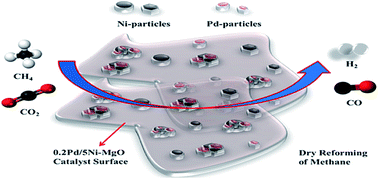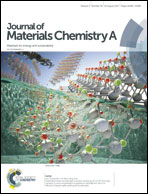Synthesis and catalytic activity of a Pd doped Ni–MgO catalyst for dry reforming of methane†
Abstract
A Pd-doped Ni–MgO catalyst was prepared for synthesis gas production by dry reforming of methane (DRM). The catalyst was prepared by a two-step method; first a high surface area MgO support was prepared by a hydrothermal method then Pd and Ni nanoparticles were deposited by sublimation of the precursor salts. The prepared catalysts were characterized by BET-surface area, X-ray diffraction (XRD), transmission electron microscopy (TEM), X-ray photoelectron spectroscopy (XPS), temperature programmed desorption (CO2-TPD), Raman spectroscopy, FT-IR spectroscopy and temperature programmed reduction (H2-TPR) analysis. Both Ni–MgO and Pd/Ni–MgO were highly active for the DRM reaction. Addition of Pd-nanoparticles to the Ni–MgO catalyst decreased the reaction initiation temperature by 90 °C and increased the rate of H2 and CO production during catalysis. The increased activity of the Pd/Ni–MgO catalyst was due to the easily reducible Ni-oxide particles and much smaller Pd-particles, which were active for the DRM reaction at lower temperature. The best feature of the synthesized catalysts was the ability to inhibit the reverse water gas shift (RWGS) reaction, which highly improved the H2/CO ratio. In fact, the Pd/Ni–MgO catalyst almost stopped the RWGS reaction and the presence of water in the reaction product was negligible. A time on stream (TOS) study of both the catalysts showed absolutely no deactivation even after 100 h of reaction at 750 °C. Both catalysts showed production of synthesis gas with a H2/CO ratio of 0.97–0.99 during the TOS study.



 Please wait while we load your content...
Please wait while we load your content...